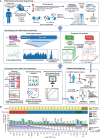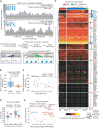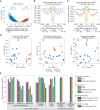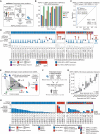Nucleosome Patterns in Circulating Tumor DNA Reveal Transcriptional Regulation of Advanced Prostate Cancer Phenotypes
- PMID: 36399432
- PMCID: PMC9976992
- DOI: 10.1158/2159-8290.CD-22-0692
Nucleosome Patterns in Circulating Tumor DNA Reveal Transcriptional Regulation of Advanced Prostate Cancer Phenotypes
Abstract
Advanced prostate cancers comprise distinct phenotypes, but tumor classification remains clinically challenging. Here, we harnessed circulating tumor DNA (ctDNA) to study tumor phenotypes by ascertaining nucleosome positioning patterns associated with transcription regulation. We sequenced plasma ctDNA whole genomes from patient-derived xenografts representing a spectrum of androgen receptor active (ARPC) and neuroendocrine (NEPC) prostate cancers. Nucleosome patterns associated with transcriptional activity were reflected in ctDNA at regions of genes, promoters, histone modifications, transcription factor binding, and accessible chromatin. We identified the activity of key phenotype-defining transcriptional regulators from ctDNA, including AR, ASCL1, HOXB13, HNF4G, and GATA2. To distinguish NEPC and ARPC in patient plasma samples, we developed prediction models that achieved accuracies of 97% for dominant phenotypes and 87% for mixed clinical phenotypes. Although phenotype classification is typically assessed by IHC or transcriptome profiling from tumor biopsies, we demonstrate that ctDNA provides comparable results with diagnostic advantages for precision oncology.
Significance: This study provides insights into the dynamics of nucleosome positioning and gene regulation associated with cancer phenotypes that can be ascertained from ctDNA. New methods for classification in phenotype mixtures extend the utility of ctDNA beyond assessments of somatic DNA alterations with important implications for molecular classification and precision oncology. This article is highlighted in the In This Issue feature, p. 517.
©2022 The Authors; Published by the American Association for Cancer Research.
Figures





Comment in
- 2159-8274. doi: 10.1158/2159-8290.CD-13-3-ITI doi: 10.1158/2159-8290.CD-13-3-ITI
References
-
- Scher HI, Fizazi K, Saad F, Taplin M-E, Sternberg CN, Miller K, et al. . Increased survival with enzalutamide in prostate cancer after chemotherapy. Cabot RC, Harris NL, Rosenberg ES, Shepard J-AO, Cort AM, Ebeling SH, et al.., editors. N Engl J Med 2012;367:1187–97. - PubMed
Publication types
MeSH terms
Substances
Grants and funding
- K99 GM138920/GM/NIGMS NIH HHS/United States
- P30 CA015704/CA/NCI NIH HHS/United States
- P50 CA097186/CA/NCI NIH HHS/United States
- S10 OD028685/OD/NIH HHS/United States
- K99 GM140251/GM/NIGMS NIH HHS/United States
- R01 CA234715/CA/NCI NIH HHS/United States
- T32 CA009172/CA/NCI NIH HHS/United States
- R01 CA251555/CA/NCI NIH HHS/United States
- K22 CA237746/CA/NCI NIH HHS/United States
- DP2 CA280624/CA/NCI NIH HHS/United States
- R21 CA264383/CA/NCI NIH HHS/United States
- P01 CA163227/CA/NCI NIH HHS/United States
- R01 CA266452/CA/NCI NIH HHS/United States
LinkOut - more resources
Full Text Sources
Medical
Research Materials

